1970/1 Pasadena Art Museum With Warhol Wearing A Rudi Gernreich Dress. Meet Paige’s Date Bill Gardner. Artist DeWain Valentine. Venice Beach Studio. Art Scene LA.(Long) *Updated* 4/12/24
Posted on July 21, 2020
Around May 15, 1970, An appearance by Paige Young at the Pasadena Art Museum (PAM), was recorded by Marvene Jones of the los angeles evening news,and her photographer. Jones’ column, The Social Butterfly, focused on the Hip happenings of the LA social scene.
The occasion was a gala for the new Andy Warhol exhibit.
Warhol himself makes an appearance, obviously a big deal.
Los Angeles Evening Citizen 5/16/1970




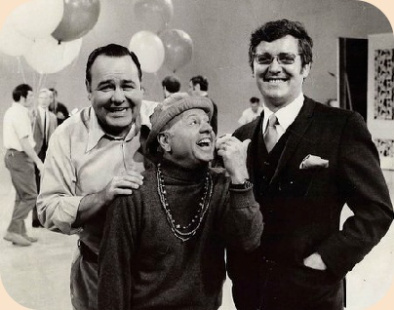
Who is Bill Gardner?
William Louis Gardner
William Louis Gardner was born in Minnesota and finished school there. He
Bill Gardner’s website
joined the US Air Force and worked at the Pentagon in the Target Library of the world. Went on to the Pasadena Playhouse to learn television and movie making. He got a job with actress Marion Davies at her home. There He met a movie agent and started a career in Hollywood. William Louis Gardner has worked in Hollywood as the agent, personal secretary, PR advisor and manager for for Mickey Rooney, Jonathan Winters, Jill St.John, Bobby Van and director, John Huston. William Gardner is the author of two books, “Confessions of a Hollywood Agent,” and “The Games End.”
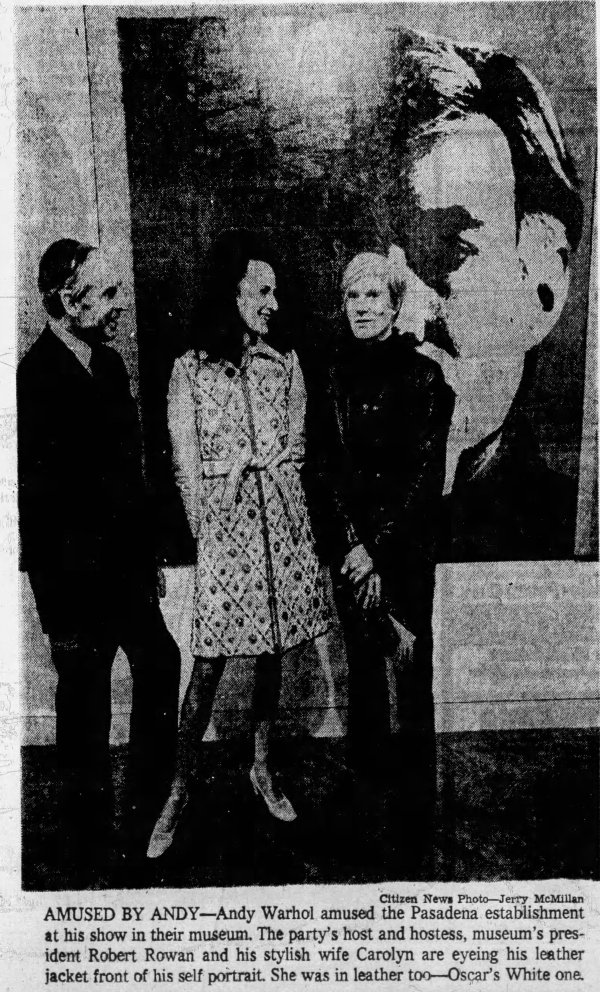
According to the Jones article, column 2 above, Paige Young and Andy Warhol discuss a role for Paige in an upcoming Andy Warhol film. It’s not something that ever happened. I think the two were making flirty small talk. Ironically, Paige mentions Warhol and the Pop Art scene in an interview with Playboy magazine.
She said about Pop Art “it gives me a headache.” “I wouldn’t waste my paint on it.”
Marvene Jones also says that Mr. and Mrs. DeWain Valentine made up a foursome that evening with Paige and Bill Gardner. Valentine had an exhibit showing some of his large cast polyester resin pieces at the Pasadena Art Museum. It was being shown right along with the Warhol exhibit.

LAT? PAM has been called the Norton Simon Museum since October 1975. A very interesting LA-Hollywood story itself.
Los Angeles Time March 10, 1968.

DeWain Valentine was one the the hottest young rising artists in the 1960s Venice Beach art scene.
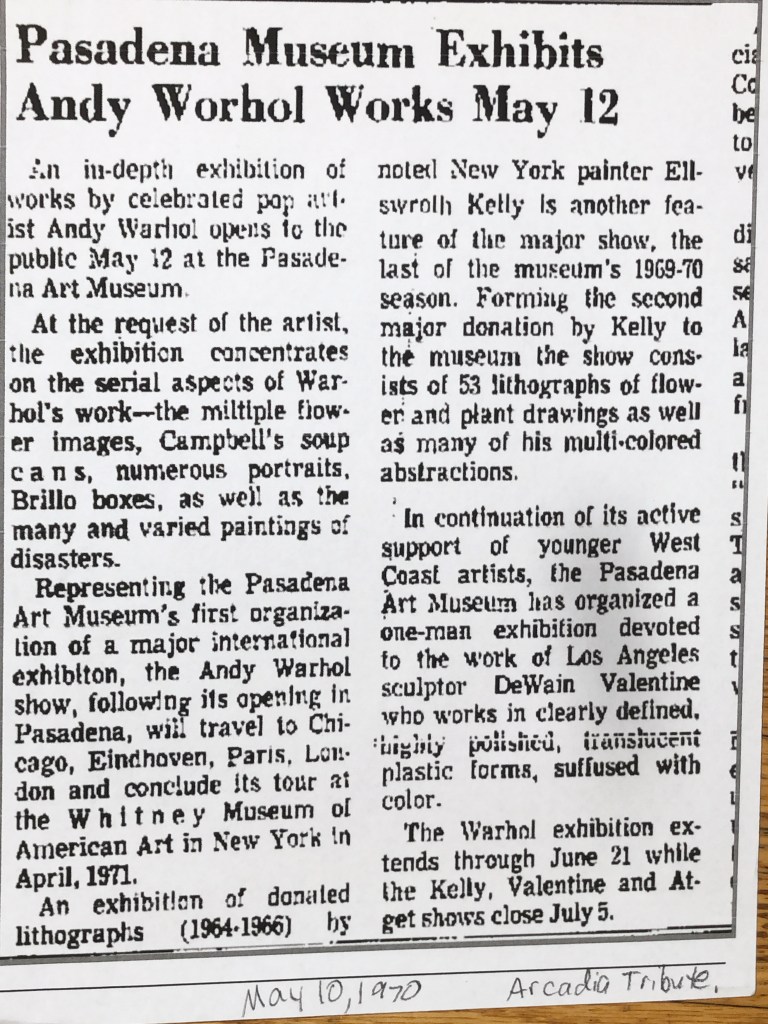
Valentine is considered an innovator in the “Light and Space” art movement along with artists Larry Bell, Robert Irwin, Helen Pashgian, James Turrell, John McCracken, Fred Eversley, and Doug Wheeler.

Many of these artists lived in Venice Beach due to the cheap rent. They were continuing a practice well established by this point in time.
Some brief Background for context of the Venice Beach Art scene:

Before
the Light and Space artists emerged, the Cool School or Ferus Gallery artists, had already established themselves beginning in the early 1950s.
The Southern California based Ferus Group includes: Ed Keinholz (original part owner) , Wally Berman, Billy Al Bengston, Ed Ruscha, Larry Bell, Robert Irwin, Ed Moses, Craig Kauffman, Ken Price, John Altoon. Artists Jay DeFeo and Sonia Gechtoff from San Francisco and the curators and owners of the Ferus Gallery who helped bring them to renown, Walter Hopps and Irving Blum. Walter Hopps had an eye for cutting edge art. New York artists were shown at Ferus too, like Andy Warhol, Robert Rauschenberg, Roy Lichtenstein and Frank Stella.
AI Overview:
The Ferus Gallery in Los Angeles, California, operated from 1957 to 1966. The gallery was founded by artist Ed Kienholz and art connoisseur Walter Hopps, and was named after James Farris, who committed suicide. The gallery’s inaugural exhibition, Objects on the New Landscape Demanding of the Eye, ran from March 15 to April 11, 1957. The gallery is known for exhibiting works by many artists from the west coast and east coast, including Andy Warhol, whose first solo exhibition, Soup Cans, took place at the Ferus in 1962
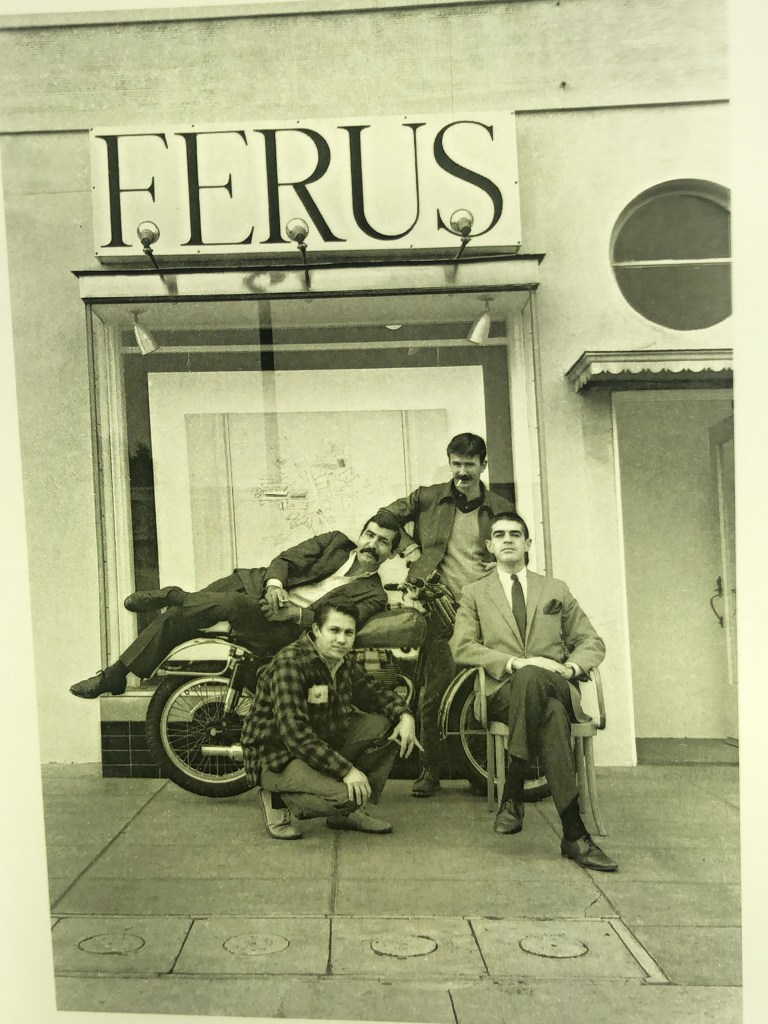
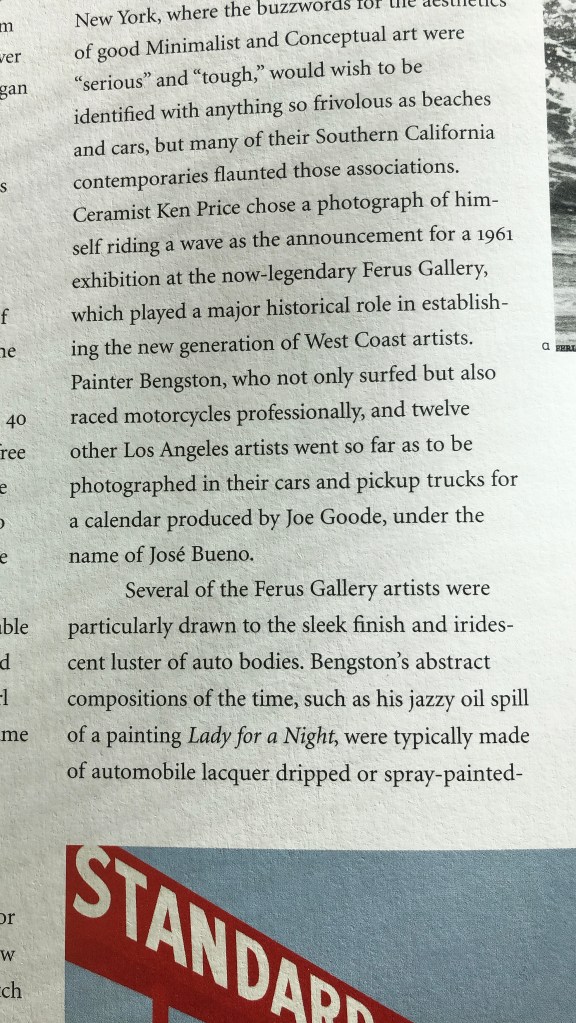
Many of southern California artists the lived in Venice Beach.

Andy Warhol, Irving Blum in background, Billy Al Bengston, Dennis Hopper, unidentified. At the DuChamp retrospective in 1963 Pasadena Art Museum. Photo by the legendary Julian Wasser.
The artists were allowed to live and create far away from the competitive and critical New York City art world.
Ed Moses once said “No one cared what we were doing.”
The Ferus Gallery gang famously interacted with Andy Warhol during his well documented stay in Los Angeles in the early 1960s. Warhol drove with actor Taylor Mead, assistant Gerard Malanga and painter Wynn Chamberlain from NYC to LA.
It was Warhol’s very first trip to LA.
The trip was to catch opening night for Warhol’s 2nd exhibit at Ferus.

Alongside this growing art scene in Venice Beach in the 1950s and early 1960s, the “Beatnik Scene” was happening and was documented by author Lawrence Lipton.
Lawrence Lipton observed and wrote about the characters of the beatnik culture in Holy Barbarians, while he was living in Venice West, California.
Valley Times. November 7, 1959. The year that Holy Barbarians was published. Beatniks became a fad into the early 1960s and permanently after that..

Venice Beach and Hermosa Beach communities in LA, North Beach in San Francisco and Greenwich Village in NYC were the hotspots for Beats and Beatnik culture.

Reader, I would imagine you have at least some familiarity with the Beatnik trope or stereotype.
Here is a cliche image of a beatnik girl with coffee, cigarettes, a black beret, black clothing and snapping fingers to poetry and bongo drums in a coffee house.
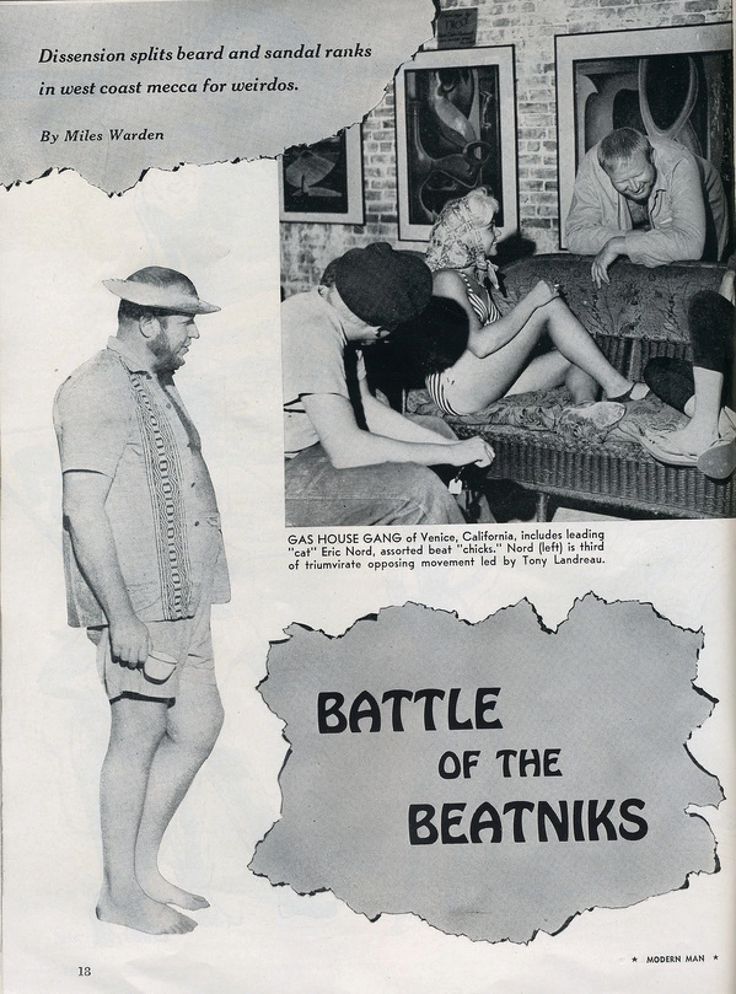
1959 movie poster for a movie about Beatniks: Mr. Tucker, proprietor of a Los Angeles coffee house, hires three down-on-their-luck classic beatnik patrons: out-of-work actor John Mapes; struggling writer Ray Miller; and George Leland, the wayward son of movie star Rita Leland, to participate in an armored car robbery to take place during a four-hour stopover in Chicago during the trio’s train trip from Los Angeles to New York. Mapes’ worried wife Jeanne joins him on the train, concerned about his not having had a job in more than a year. (wikipedia)
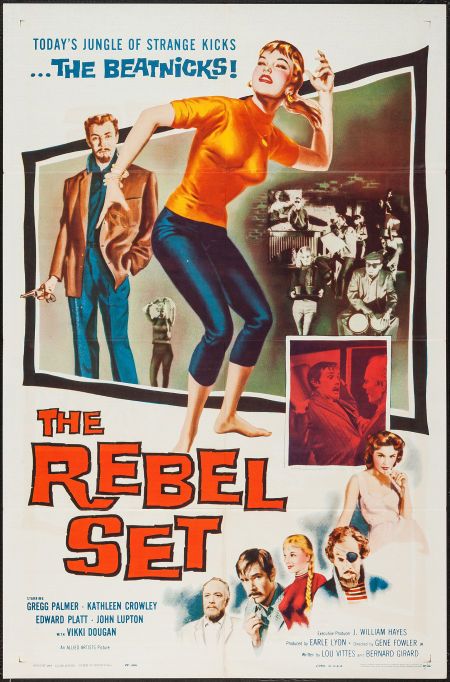
The Ferus ‘Studs’ the new generation of artists, young abstract painters, ceramicists and assemblage makers who had been flying under the wire now were the featured artists at the Ferus Gallery. The Gallery was ripe for the adventurous artists who would set the new bar in contemporary styles. The Ferus Gallery had belief in the performance of their work and was one of the first galleries to support it.
Ferusgallery.com

END
Out of this milieu was born the Light and Space movement in the mid-1960s.
DeWain Valentine was a key player in Light and Space along with Larry Bell, Doug Wheeler and Robert Irwin.
Originally from Ft. Collins, Colorado, Valentine developed a type of polyester resin material that allowed him to make large scale pieces like the one shown below.
Previously the material would crack when making a piece this size: approx: 17 1/4x 17/4 x 7/8.
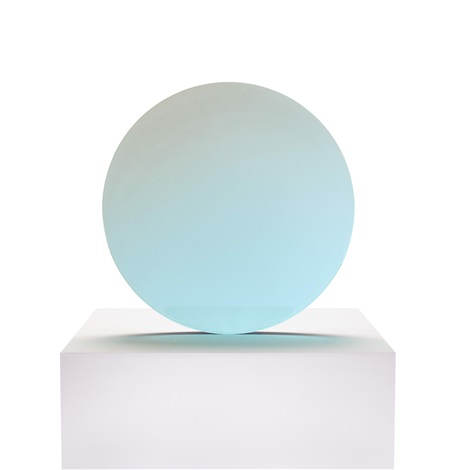
Valentine was a newcomer to Venice Beach compared to the others artists, arriving in 1965. It appears he was a fairly quick success on the West Coast.
For much more detail on these art movements which established the Los Angeles art scene as one on par with New York City or even Europe, watch the documentary “The Cool School,” available on Netflix. Or the book referenced above.
Richard Sample
told me that after he moved to a studio-home in Venice (late 1960s) he invited Paige to move in with him.
I think it was Richard’s father, artist and western jewelry maker Charlie Sample, who was able to get Richard the studio space in Venice Beach.
I asked Richard the location and he said he could not remember it, but that it was quite close to the ocean and his artist neighbors and friends were, DeWain Valentine and Larry Bell. (See chapter: Interview with Richard Sample)

Paige refers to her “new Venice art studio” and the art scene there, in several interviews with Playboy magazine and US newspapers in 1969 and 1970. (See chapter: Most Public Year 1969)
Richard Sample and Paige Young joined the community of Venice artists, but were “not working with the new materials,” to quote Paige in an interview. She was referring to her neighbors and friends, Valentine, Bell and Irwin, etc.


De Wain Valentine, Concave Circle Blue Green, 1968–2017. Cast polyester resin, 23 1/2 x 23 1/2 x 9 7/8 inches. © De Wain Valentine. Courtesy of the artist and Almine Rech. Photo: Melissa Castro Duarte. Brooklyn Rail.

Paige mentions Venice Beach as an “art colony,” where she now lives.
Philadelphia Inquirer Jun. 27, 1969
After a long search I found the location of this Venice studio: 62-68 Market St.
Research and interviews show that Robert Irwin lived across the street from Valentine. This was not mentioned by Richard Sample. At one point I asked him if he “knew Ed Ruscha or Robert Irwin” and some others. He did not recognize those names, he was definitive about Larry Bell and DeWain Valentine.
Richard Sample’s niece Ellen Sample remembers visiting her uncle and grandfather Charles Sample at the art studio/home in Venice Beach. Charles Sample was a jewelry maker and had a retail storefront in addition to his studio.
Ellen, a child at the time, remembers hearing frequent talk about a man named “Valentine.”
Richard and Ellen both recalled being able to see the beach from the studio. 62-68 Market St., a block from the ocean, is a large structure and was divided amongst many artists who rented their own studio according to Ellie. This is why the address lists a range of numbers.
Richard Sample is listed with an address of 63 Market St. Venice, in a newspaper marriage announcement, 1968.
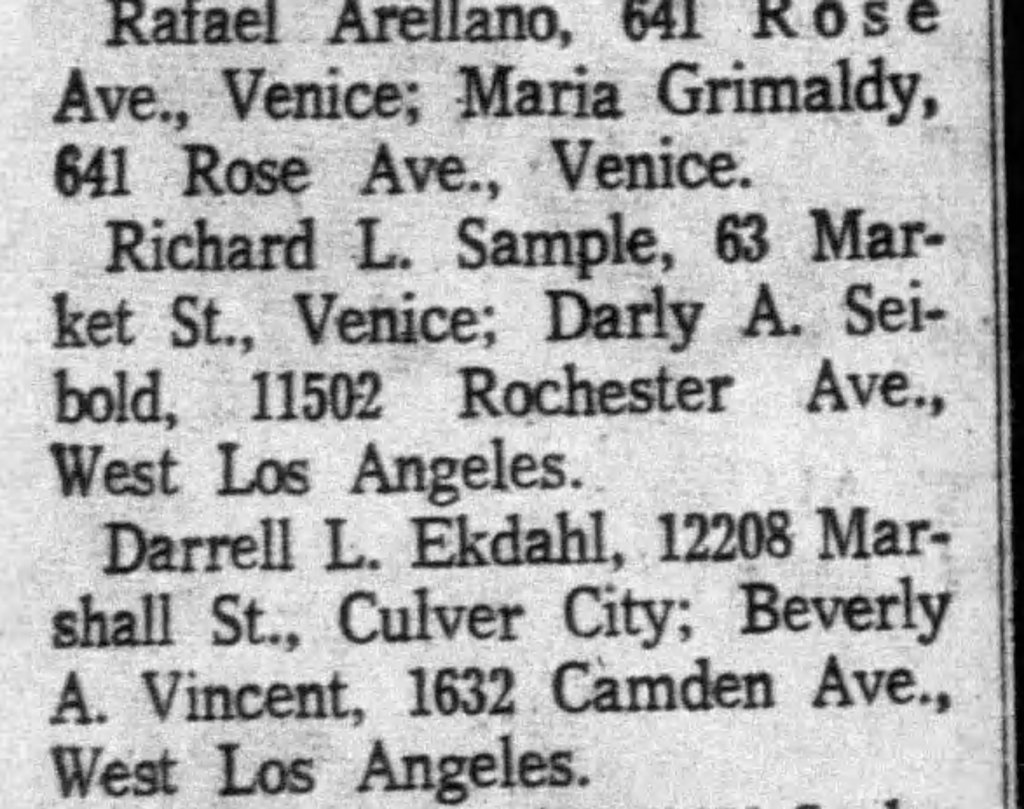
Ellen texted me a story: she thinks her Uncle Richard sublet the Venice studio to Paige at one point.
Ellen recalls “tensions” regarding Paige amongst Ellen’s aunts. These women were the wives of Charles Sample and his sons.
Ellen said her own mother was not bothered by Paige living at the studio, but that her mother did “go with her sister-in-laws to see what was going on at the studio.” Ellen says the most tense time was when Paige’s Playboy issue was current and shortly after.
Richard Sample told me he was forced to ask Paige to leave the Venice studio because she never paid him rent. (See chapter Richard Sample interview)
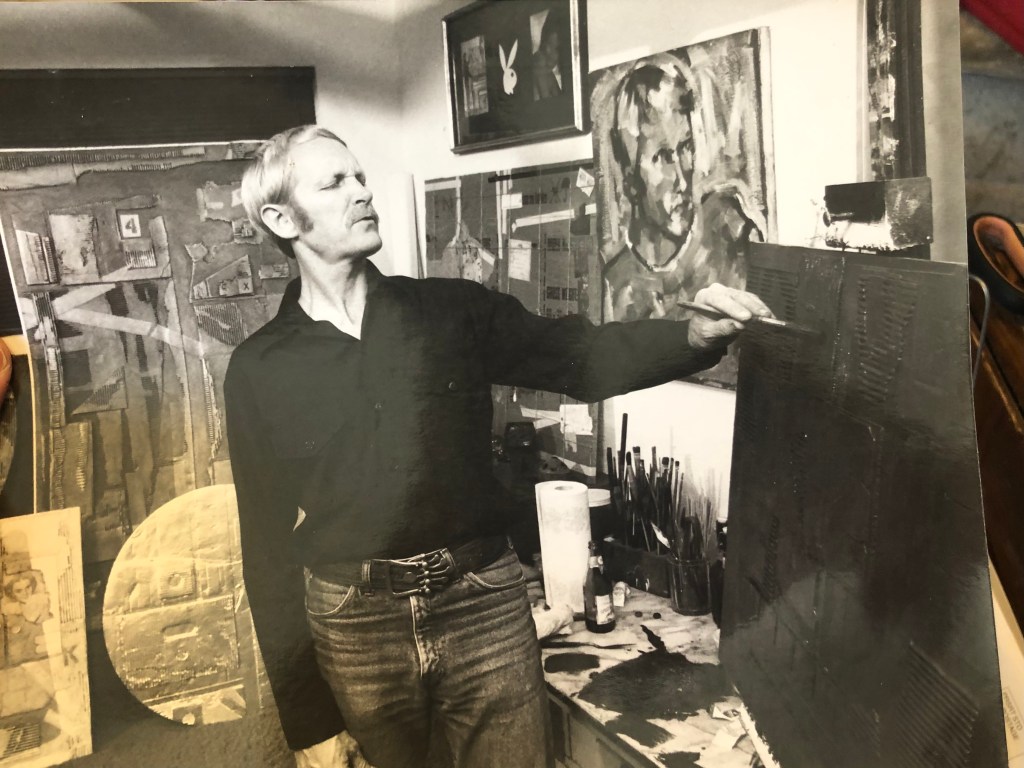
I asked Ellen if it was a possibility that Richard felt pressured to ask Paige to leave due to the tension.
Ellen said she thought it was possible, but just didn’t know for certain.
DeWain Valentine has spoken about his Venice studio in several art magazine interviews and the influence it had on his art.
His ex-wife told me in a telephone conversation that Paige was one of many women with whom Valentine “slept with” during those days. Mrs. Valentine confirmed Paige was a women on the Venice scene and saw her on social occasions. She remember the night at the Pasadena Art Museum, but not specifically that she double dated with Paige. Mrs. Valentine thinks she could have gone by herself that night but was seen with her ex and Paige. She does not recall knowing Bill Gardner, Paige’s date of the evening. I need to confirm that Mr. valentine learned about the studio through Richard Sample.
And Mrs. Val. remembers Richard being a friend of Paige.
DeWain Valentine fondly remembers the friendships with his many fellow artists, Larry Bell and Robert Irwin, particularly the years of the 1960s and early 70s.


DeWain Valentine above states that he lived in and eventually purchased the 62 -65 Market St.
And indeed, several records with his signature and name can be seen in public building archives from LA County, now available online. Copy of one seen below.
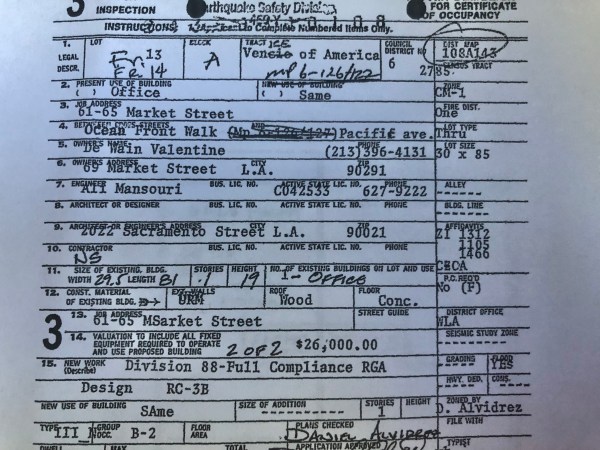
61-65 is the address listed here.

DeWayne Valentine spent many years living and creating art in Hawaii after the 1970s. He and the Mrs. Valentine mentioned in the Marvene Jones article, divorced at some point. He remarried and stayed married to the 2nd Mrs. Valentine until his death on February 2, 2022.
When he moved back to LA from Hawaii, it was to a large studio and home in Gardena.
.

From the Documentary “The Cool School.” Market St, where Valentine, Bell and Irwin had studios. And Richard Sample and Paige Young made art and lived, briefly. I would say Paige lived there about one year.
Category: 1970s, LA Locations, PMOM, Popular Culture Tagged: #Paige Young, 1970sfad, 1970sLA, 1972, Alice Gowland, Andy Warhol, Beatnik, Beatnik culture, Bill Gardner, Billy Al Bengston, Carolyn Rowan, Cool School, Dennis Hopper, DeWain Valentine, Ed Keinhoz, Ed Ruscha, Elsworth Kelly, Ferus Gallery, Glamour Photography, Irving Blum, John Altoon, Jonathan Winters, Larry Bell, Light and Space Art, Los Angeles architecture, Los Angeles History, Norton Simon, PAM, Pasadena, Pasadena Art Museum, Richard Sample, Robert Irwin, Robert Rowan, Rudi Gernriech, Santa Monica Blvd., Taylor Mead, Venice Art scence, Venice Beach, Venice Beach artists, Venice California, Wally Berman, Walter Hopps, Westwood
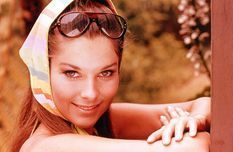 .
.